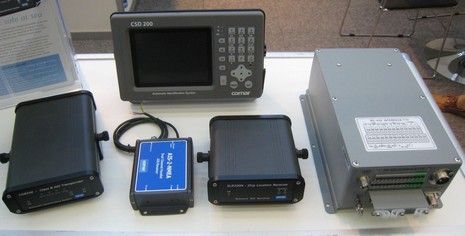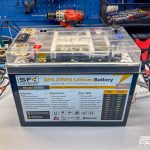Comar, AIS crazy

Comar Systems introduced no less than five new AIS products at METS, most of them seen in the photo above, bigger here. Together with Comar’s existing receiver and Class B transponder, they represent about every AIS possibility there is…except for one-channel-at-a-time receivers which Comar doesn’t believe in. Neither does SeaCas. I agree, and think they’ll go away fairly fast once navigators see how slow one-channel-at-a-time Class B plotting is, and also as Class B hardware becomes less expensive. At any rate, here’s a page of new Comar gear, including a lower cost ($440 retail) true dual channel receiver, an Etherneted IP-talking receiver (the more shore stations the better!), and a $3,000 Class A transponder that might possibly be fit on non mandatory vessels without the need for the separate $1,150 display. Meanwhile, Panbo reader Kurt Schwer, blogging from the eNavigation 2007 conference in Seattle, reported that the USCG’s Jorge Arroyo predicted that U.S. Class B sales will start in December. A thank you to Kurt, and let’s hope.













Ben .. your disparaging comments about single channel receivers may well have some validity as regards plotting Class B targets BUT my concern has always been for those ‘biggie’ Class A targets, recognizing that in the future there will be more Class B’s. My experience with the Nasa AIS-Engine, using the Yacht-AIS Pro software, is that from the time of start up until I begin to get targets is less than one minute. And it appears that the closest ones are detected first. Sure, these targets only have their MMSI and GPS data at first but it’s enough for the software to begin calculating collision potentials and ‘safe passage’ areas. Once a target is detected, the position data is received every 20 seconds versus 10 seconds for a dual-channel receiver. I have a capture file available for anyone that is interested to see this happening in real time. It shows 23 targets in the first 30 seconds. My contact details are on my website.
The budget minded cruiser should think twice about paying more than twice as much for a receiver that only gives the same data in 10 seconds instead of 20 seconds.
Terry
I am confused Yachtvalhalla. Are you saying that the single channel is fine because you still get most of the benefit in the first 30 seconds, or that Class-A biggie targets are slow, the Nasa AIS-Engine or Yacht-AIS software compensates in some manner, or some other reason ?
Thanks
I am saying that Ben’s comment “once navigators see how slow one-channel-at-a-time Class B plotting is” doesn’t make a solid case for doing away with single channel receivers. The Class B updates are every 30 seconds so single channel receivers get them every minute, compared with every 20 seconds (or less) for Class A targets (which are my main concern, especially where I sail here in the Singapore and Malacca Straits). The 30 second figure I gave is the time from first turning on the unit until I have the majority of targets around me being displayed. The cost-benefit trade-off for the cruiser, between Miltech Marine’s receivers, is $250 .. which equates to 30 bottles of Famous Grouse scotch.
Jeezumcrow, Terry, when you put your argument in terms of Famous Grouse scotch, well, you have a case, a few cases actually. And I really glad that poorly made NASA receiver has worked out for you. Knock on wood it keeps on working. But, really, what’s a few hundred dollars in a cruising boat’s budget it if means greater AIS reliability and more timely target plotting?
In my neck of the woods I encounter large ships as well as fast ferries and fast moving pilot boats. Some of these do not slow down much during periods of limited visibility. So a am willing to give up a few bottles of Don-Q rum in favor of a faster refresh rate.
One occasion I really needed faster access to the static information was during the Lake Ontario 300 race last July. We were approaching Toronto from the south west, under spinnaker. It was 2am, and I was really tired. Seemingly out of nowhere, two class A vessels appeared on my plotter. They were close together, in line astern, and I thought they were towing. They were on collision course, about ten minutes way. We could not see their lights against a mass of bright shore lights. The only way we could keep clear was by jibing, which would have lost us a lot of ground in the race. So I waited for the static AIS information to see what kind of ship it was… and I waited… and I waited… They were behaving very erratically, and the towed vessel seemed to be drawing abeam of the towing vessel! About four minutes from collision, we still could not see anything. If there were really two ships there, it would have blotted out an area of the shore lights. I did not know whether to beleive my senses, which said there was nothing there, or my electronics. Finally, I made radio contact, the old fashioned way with an “all ships” call. It turned out they were two small harbor tugs, and they had me on radar and were planning to keep clear. If I had know the size and type of vessel, and the name of the ship, it would have saved me a very anxious 5 minutes.
I sail in an area frequented by several HSC’s (High speed craft) that can top 40knots, they can go a long way in 10 seconds and a lot further in 20, so I’m all for the 2-channel Rx’s (ok, so I’m biased, the dual channel Rx I’ve got was designed by a bunch of my friends – I’m using the prototype… so far so good… just got to repair my PDA that gets used as the plotter screen…).
Terry’s comments on ‘single channel’ receivers demonstrate a widely held misconception about so called ‘dual channel receivers’. A single channel receiver can of course only receive on one of the two channels used by AIS. Transmissions from a target are generally spread about equally between these two channels so that updates will be seen on both channels, but only for about HALF the time on each. This is not a serious problem with moving Class A targets which are transmitting typically every 2,3,6 or 10 seconds as pretty well any receiver will get approaching 50% of the avialable date, depending on the sensitivity of the receiver.
However, to get a good solid plot that aquires the detailed data of name, type etc. which is only transmitted every few minutes, the more updates you can receive the more reliable and accurate your information is going to be.
Several manufacturers claim to supply ‘dual channel receivers’ which, while they are capable of receiving transmissions on the two frequencies, cannot do it AT THE SAME TIME. These ‘flip-flop’ units are really scanning between two channels and picking up the first available signal, they are not looking at both channels similtaneously. Again, this is not too much of a problem YET because the channels are not running at capacity except in very busy commercial waters. In these cases, genuine two channel DUPLEX receivers show significantly more information than either single channel or ‘flip-flop’ dual channel receivers.
As the airwaves get busier with more vessels being fitted with AIS (and we have not started yet!) the proper duplex receivers will show their superiority, particulary when Class B kicks off with it’s considerably slower update rate of 30 secs.
Just consider the entirely likely scenario of a 45ft sports cruiser making 35kts transmitting Class B signals every 30 seconds (about one third of a mile between transmissions). Unless you have 100% coverage of the available transmissions there is a 50/50 chance you will miss it, and if this were to happen two or three times in a row the consequences could be dire! Unlikely you may say, but how much do you normally bet on red OR black when playing roulette?
Gentlemen,
I am planning a non-stop circumnavigation and would like to have AIS Class B with an alarm output in case I am sleeping or other wise occupied. Does anyone know if this exists?
glen — the short answer is “yes,” but you have to consider not just the AIS unit but the display software. I feed my AIS data into Fugawi, and i get each ship displayed on the PC screen and with it TCPA and CPA information. I also have the ability to make an alarm sound under conditions I can set.
Other programs do similar things. Chartplotters seem to have more limited capabilities, but they about all have some way to program an alarm.
Hope this helps,
Michael
Glen, Class B transponders typically don’t have a display, and hence don’t plot or alarm targets. However, most every modern multifunction display and PC charting program can take target data from a Class B transponder, plot it and sound alarms based on CPA/TCPA settings. In other words, you can accomplish what you want in many ways. Take a good look at the Vesper Marine AIS WatchMate, though, because it is especially designed for blue water sailing…
https://panbo.com/archives/2010/01/standalone_ais_–_new_dy_vesper_icom.html